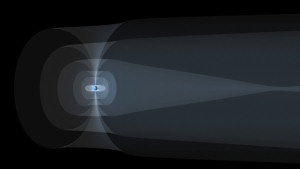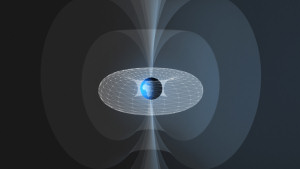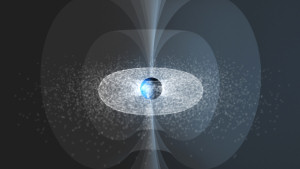Cluster discovers steady leak in Earth's plasmasphere
2 July 2013
A steady wind, discovered by ESA's Cluster mission, is slowly escaping from Earth's plasmasphere - the torus of plasma that surrounds our planet's atmosphere. The outflow amounts to almost 90 tonnes a day. Predicted by theory two decades ago, this is one of the main mechanisms that replenishes Earth's magnetosphere with fresh plasma.| Animation of the plasmaspheric wind. Credit: ESA/ATG medialab. Click here for further details and larger versions of this video.) |
The environment that surrounds Earth, beyond the outermost layers of the atmosphere, is strongly shaped by the magnetic field of our planet. There, space is filled with electrons and positive ions, which move along the magnetic field lines. The interaction between Earth's magnetic field and the solar wind produces the complex topography of the magnetosphere.
The innermost part of the magnetosphere is a doughnut-shaped region called the plasmasphere, which is centred around the Earth's equator and rotates along with it. This plasmasphere, whose toroidal shape is forged by the magnetic field of Earth, exchanges mass and energy with the outer layers of the magnetosphere, and scientists have been studying the details of the interaction between these two regions.
"We have long known that the plasmasphere supplies material to the outer magnetosphere," explains Iannis Dandouras from the Institut de Recherche en Astrophysique et Planétologie (a joint CNRS and Université Paul Sabatier institute) in Toulouse, France.
"However, up until now we could only see this happening during sporadic, localised and powerful events that we call plumes."
Analysing data from ESA's Cluster mission, Dandouras has discovered another source of the supply: a steady wind that continuously transfers material from the plasmasphere into the magnetosphere. The results of his study are published in Annales Geophysicae.
"Now we have finally found proof of a permanent and continuous leakage of material from the plasmasphere outwards," he says.
"It is something similar to what happens also around the Sun, when the solar corona expands outwards at equatorial latitudes and gives rise to the solar wind."
 |
| Earth's magnetosphere. Credit: ESA/ATG medialab |
Scientists had suspected that such a plasmaspheric wind must exist ever since the first observations of plume events in the early 1990s. Plumes are dense columns of plasma that form in the plasmasphere when it is hit by a geomagnetic storm – a disturbance in Earth's magnetic environment caused by sudden changes in the solar wind. After they form, plumes expand outwards and eventually burst, releasing large amounts of fresh plasma in the outer layers of the magnetosphere.
"When a plume strikes out, it partially drains the plasmasphere, which is then replenished with plasma coming from Earth's ionosphere, the top layer of the atmosphere," explains Dandouras.
Early studies of plumes monitored how long it took to refill the plasmasphere after such an event.
"Surprisingly, this process took much longer than expected, like trying to fill up a leaky container."
In 1992 two scientists approached the problem from a theoretical point of view. When Joseph Lemaire, from the Belgian Institute for Space Aeronomy in Brussels, Belgium, was visiting Robert Schunk at Utah State University, USA, they tried to simulate this puzzling finding by investigating the interplay of forces in the plasmasphere. Their study revealed a net imbalance between three players: the gravitational attraction due to Earth's mass, the centrifugal force caused by its rotation and the pressure exerted by the plasma. As a result of the imbalance, an instability develops, driving the plasma outwards.
 |
| The plasmasphere in Earth's magnetosphere. Credit: ESA/ATG medialab |
The instability predicted by the work of Lemaire and Schunk is continuous rather than episodic, and takes the form of a wind of plasma. The wind is continuously flowing radially out of the doughnut-shaped plasmasphere and into the surrounding layers of the magnetosphere.
It was Lemaire who first introduced Dandouras to this particular problem.
"We were chatting about the plasmasphere at a workshop a few years ago, when Joseph Lemaire mentioned his and Schunk's prediction of this wind," remembers Dandouras.
"Quite some time had passed after their work had been published, yet only indirect evidence was found to support their prediction. As an experimental space scientist, this triggered my curiosity immediately.
"The Cluster mission was already operating and collecting data at the time, and we both agreed that the Cluster Ion Spectrometry experiment (CIS) would be the perfect tool to verify directly whether the plasmasphere is actually leaking."
The plasmaspheric wind is expected to be blowing at all times, regardless of the activity of the magnetosphere; in contrast, plumes only arise when Earth's magnetic environment is highly active. So Dandouras dug into the Cluster archive looking for data that had been gathered during quiet magnetospheric times.
"The inquiry was a very delicate process: if at all present, this wind would be very weak, and it would be really challenging to single it out from the overall distribution of the low-energy ions that make up the plasmasphere," says Dandouras.
But the high sensitivity of the CIS experiment proved crucial to the study, along with a specially developed filtering technique.
 |
| The plasmaspheric wind. Credit: ESA/ATG medialab |
"After long scrutiny of the data, there it was, a slow but steady wind, releasing about 1 kg of plasma every second into the outer magnetosphere: this corresponds to almost 90 tonnes every day. It was definitely one of the nicest surprises I've ever had!"
At this rate, the mass loss is a negligible contribution to the depletion of Earth's atmosphere, whose mass amounts to over 1018 kg. However, this constant outflow plays a significant role in the supply of plasma to the outer magnetosphere, surpassed in efficiency only by the solar wind, which is also a steady source, and by the occasional and powerful plumes.
"This discovery confirms that Earth's ionosphere and plasmasphere feed the magnetosphere on a regular basis, and not only during active periods," comments Philippe Escoubet, Cluster Project Scientist at ESA. "This allows us to study Earth's atmospheric loss in great detail and to compare it with similar phenomena that occur on other planets in the Solar System at different rates, depending on the intensity of each planet's magnetic field."
Notes for editors
The study presented here is based on data gathered with the Cluster Ion Spectrometry (CIS) experiment on board the Cluster spacecraft on three occasions in 2001, on two occasions in 2002 and once in 2006.
Cluster is a constellation of four spacecraft flying in formation around Earth. It is the first space mission able to study, in three dimensions, the natural physical processes occurring within and in the near vicinity of the Earth's magnetosphere. Launched in 2000, it is composed of four identical spacecraft orbiting the Earth in a pyramidal configuration, along a nominal polar orbit of 4 × 19.6 Earth radii (1 Earth radius = 6380 km). Cluster's payload consists of state-of-the-art plasma instrumentation to measure electric and magnetic fields over wide frequency ranges, and key physical parameters characterising electrons and ions from energies of near 0 eV to a few MeV. The science operations are coordinated by the Joint Science Operations Centre (JSOC) at the Rutherford Appleton Laboratory, United Kingdom, and implemented by ESA's European Space Operations Centre (ESOC), in Darmstadt, Germany.
Related publications
I. Dandouras, "Detection of a plasmaspheric wind in the Earth's magnetosphere by the Cluster spacecraft", 2013, Annales Geophysicae, 31, 1143-1153, doi:10.5194/angeo-31-1143-2013
J. F. Lemaire & R. W. Schunk, "Plasmaspheric wind", 1992, Journal of Atmospheric and Terrestrial Physics, vol. 54, p. 467-477
Contacts
Iannis Dandouras
Principal Investigator of the Cluster Ion Spectrometry experiment (CIS)
Institut de Recherche en Astrophysique et Planétologie (IRAP)
CNRS and Université Paul Sabatier
Toulouse, France
Email: Iannis.Dandouras![]() irap.omp.eu
irap.omp.eu
Phone: +33-5-61558320
C. Philippe Escoubet
Cluster Project Scientist
Research and Scientific Support Department
Directorate of Science & Robotic Exploration
ESA, The Netherlands
Email: Philippe.Escoubet![]() ]esa.int
]esa.int
Phone: +31-71-565-3454




